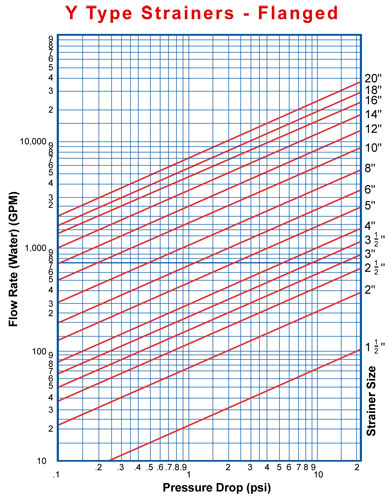Pressure drop is defined as the difference in total pressure between two points in a fluid carrying network. Pressure drop occurs when frictional forces, caused by the resistance to flow, act on a fluid as it flows through the pipe. The main determinants of resistance to fluid flow are fluid “velocity” through the pipe and fluid “viscosity.” Pressure drop increases proportional to the frictional shear forces within the piping network.1
Pressure drop is also affected by what’s called the ‘roughness’ of the piping network. These are things like surface roughness, divergence i.e. ‘turns’, fittings and joints, in other words, anything that would stand in the way or slow down the smooth movement of the liquid moving through the network.
High liquid viscosities and or high flow velocities can result in a larger pressure drop, while no pressure drop or lower pressure drop is a characteristic of low velocity.
Obviously, strainers that are designed to remove particles and other obstructions from the fluid will affect the pressure drop.
Most pump installations that have been designed for reasonable velocities will allow for an approximate 2 psi pressure drop across the strainer. But if there is a strainer involved and that strainer becomes clogged, the pressure drop will obviously increase.
The amount of this pressure drop increase will vary with a whole list of factors such as the type of strainer being used and the clogging pattern.
Sure Flow does our best to estimate the change in pressure drop at various percentages of clogging, but it is very difficult to relate actual line performance. This is simply because of the various characteristics involved with the strainer clogging. For example, a ¼” perforated basket which is two-thirds full of ½” stones will have less pressure drop than a relatively small amount of leaves on a large 100 mesh basket.
The open area ratio (OAR) or capacity ratio of a strainer will influence such characteristics as the created pressure loss and the length of time if can operate without a cleaning. The OAR is the relationship between the open flow area of the material which makes up the strainer element and the internal cross-sectional area (flow area) of the pipe.
When a screen or basket reaches the maximum differential pressure it can withstand before it fails, it is known as the ‘burst pressure’. Burst pressure is dependent on many factors and it is difficult to calculate. These can include the thickness of the construction material and the material itself, the geometry and size of the strainer and the open area percentage of the perforation used in the strainer.
Obviously, it is recommended you never allow the pressure drop across a strainer to approach the burst pressure of the strainer. That’s where Sure Flow’s decades of experience fabricating strainers and helping customers with calculations like pressure drop is tailored to your specific requirements.
Here’s a general sample of chart which shows Flow Rate Vs. Pressure Drop in a Y Strainer with a Clean Screen.

There are some sources online which have tried to automate the calculation of pressure drop and we believe they are somewhat deficient.
That’s why we encourage you to call our expert team at 800-263-8251 to get the pressure drop calculation you require.
When you see what we require to calculate a specific pressure drop you can see why it would be pretty tough to incorporate all the factors into a simple web-based application.
If requesting a pressure drop for a liquid we require:
- The pressure the unit will operating in (psi)
- The liquid flow rate (GPM)
- Perf/mesh size of the screen
- Specific gravity or density of the liquid
- Viscosity of the liquid (unless water)
If requesting a pressure drop for a gas, we require:
- The pressure the unit will operating in (psi)
- The temperature
- The flow rate (SCFH or SCFM)
- Perf/mesh size of the screen
- Specific gravity or density of the gas (unless it’s air)
One of the other reasons this calculation is so complex and why we encourage you to call or email us the details is that we can actually calculate the pressure drop based on percentage clogged.
Again, we’ll need details about the percentage clogged. Just asking for “dirty pressure drop” has too wide a spectrum of possibilities. We’ll need a more specific “50% clogged”, or “75% clogged.”
Just having to ask for this calculation is an important reminder of the necessity of regular cleaning and maintenance of strainers because a strainer that is too clogged can adversely affect pressure drop.
There are a lot of moving parts when it comes to making a pressure loss calculation. The results of not paying attention when you set up a system can obviously be catastrophic.
Knowing the pressure drop is critical to ensure the proper functioning of a system with fluids moving through it and liquids being strained. Installing strainers to clean and filter that liquid is also crucial.
Sure Flow is your source for pressure drop calculations. Call us at 800-263-8251 now to get your pressure drop calculation underway.
In an upcoming blog we’ll discuss some of the features we can add to our straining units like ‘differential pressure assemblies’ that enhance the information accessible to ensure the smooth operation of your fluid moving network.
1 https://en.wikipedia.org/wiki/Pressure_drop

